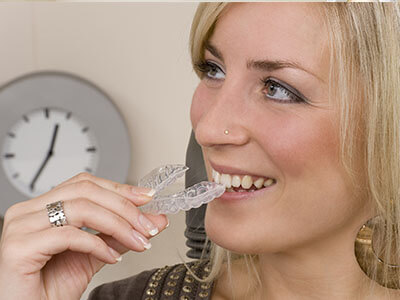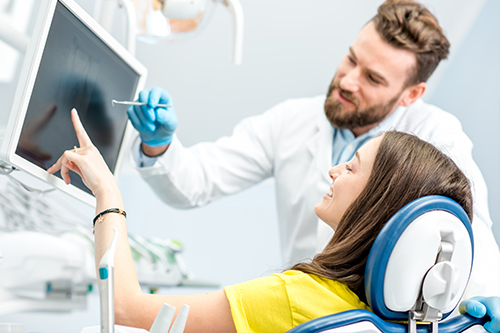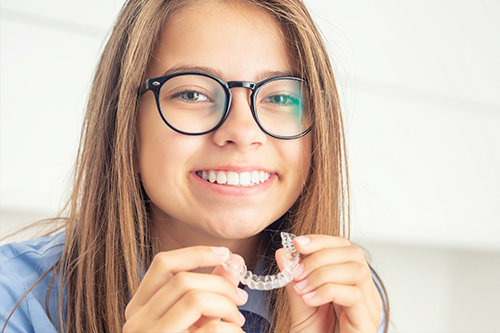North Haven Office

Our Offices
41 Middletown Ave
North Haven, CT 06473
Existing Patients: (203) 234-3900
New Patients: (203) 309-2799
Cromwell Office

Invisalign® is a modern approach to orthodontics that uses a sequence of clear, removable aligners to guide teeth into healthier, more aligned positions. This treatment blends digital planning with custom-fitted appliances to deliver results that are both discreet and predictable. At Nova Dental, we work with patients to determine whether clear aligners are a good fit for their oral-health goals and lifestyle.
Unlike traditional brackets and wires, clear aligners move teeth using a series of precisely designed trays that apply gentle, continuous pressure. Each aligner is intended to be worn for a prescribed period before being replaced by the next in the series. Over time, these small adjustments add up and produce the intended alignment changes without the need for fixed hardware attached to the teeth.
The process begins with a thorough clinical assessment and digital records. High-resolution scans or impressions capture the current tooth positions, bite relationships, and jaw alignment. Those records allow the team to visualize projected tooth movement and establish realistic treatment milestones before any aligner is fabricated.
Because each aligner is custom-made, the treatment plan can include movements such as tipping, rotation, and controlled uprighting. Complex cases are planned using software that sequences movements to achieve predictable outcomes while minimizing unnecessary forces on individual teeth. This planning helps create a roadmap that guides each aligner in the series.
The combination of removable design and careful sequencing makes clear aligners an appealing option for many patients who want effective orthodontic correction with fewer aesthetic and lifestyle compromises.
Modern clear-aligner systems rely on three-dimensional imaging and simulation tools to translate a treatment plan into a physical set of aligners. These tools allow clinicians to preview projected changes and adjust the sequence if a particular movement requires additional refinement.
Because aligners are removable, patients can brush and floss normally, which helps maintain gum health and reduces the risk of decay during treatment. That said, consistent wear—typically the majority of each day—is essential to keep the program on schedule and achieve the intended results.

The first step is an in-person consultation where a clinician reviews your dental and medical history and examines bite relationships. This visit focuses on establishing goals—whether correcting crowding, closing gaps, or addressing bite issues that affect function and comfort.
After the oral examination, digital scanning or impressions create a detailed record of tooth positions. Those records are the foundation for a customized plan that maps each aligner's intended movements and milestones throughout the course of care.
This stage also identifies any preparatory needs such as periodontal care, restorative work, or minor enamel shaping so that aligner therapy integrates safely with your overall dental health plan.

Once scans are captured, the treatment team uses digital planning software to simulate the full course of movement from start to finish. This virtual setup lets patients and clinicians review a realistic projection of how teeth will shift with each aligner change.
The simulation also helps the clinician sequence movements strategically—staggering rotations, creating room for erupting teeth, and sequencing bite corrections so forces are distributed safely and effectively.
Adjustments to the plan are possible before aligner fabrication, giving clinicians the ability to fine-tune the approach based on esthetic priorities or functional considerations.

Each aligner is produced to match the precise geometry defined by the digital plan. Materials are chosen to balance strength and flexibility so trays can apply effective force while remaining comfortable for daily wear.
Small features like attachment points—tiny composite bumps bonded to selected teeth—can provide the extra leverage needed for particular movements. When used, these are planned in advance and explained to the patient so there are no surprises.
Because aligners are trimmed and contoured for a comfortable fit, most patients report minimal irritation compared to traditional brackets. Any initial sensitivity typically subsides within a few days as the mouth adapts to the appliance.

Treatment includes regular check-ins so the clinician can monitor progress and make small plan modifications if tooth movement diverges from expectations. These visits also support oral health maintenance and address any patient questions about wear or care.
Once active movement is complete, a retention phase helps maintain the new positions. Retainers—often clear retainers similar in appearance to aligners—are prescribed to prevent relapse and preserve the investment of time and care put into alignment.
Successful outcomes depend on consistent communication and routine follow-up, ensuring that both function and esthetics are preserved over time.
To support informed decisions, many patients benefit from educational demonstrations and professional resources that explain how clear-aligner therapy works in clinical practice.
These resources focus on treatment mechanics, hygiene protocols, and strategies for integrating orthodontic care with restorative or periodontal needs. Reviewing these materials can help patients set realistic expectations and prepare for a smooth treatment experience.
*Invisalign® is a registered trademark of Align Technology, Inc.
Summary: Clear aligner therapy offers a precise, discreet path to straighter teeth while preserving daily routines and oral hygiene. From an initial clinical evaluation and digital plan to custom-fitted aligners and a thoughtful retention strategy, the process is designed to prioritize comfort, predictability, and long-term stability. If you’d like to learn whether Invisalign® is right for you, contact Nova Dental for more information and to schedule a consultation.
There are many options for patients who want to avoid metal braces! The most popular alternative orthodontic treatment is Invisalign®, which are clear plastic aligners designed to straighten teeth. After an examination of your teeth, your dentist will determine which option is best suited to your wants and needs.
According to the Invisalign® website, the cost for treatment is approximately the same as the cost for metal braces. A portion of this cost may be covered by your insurance. Please call us to set up a consultation and discuss potential payment plan options.
The first step is to schedule a consultation with your doctor, so they can devise a treatment plan that is best suited to your individual dental needs. Once approved, you will receive your first set of aligners. Your doctor will then regularly monitor the movement of your teeth and new aligners will be ordered according to the progress made in your treatment plan.
Invisalign® aligners are made of clear, flexible plastic. The company received a patent for this material – SmartTrack® – to be used exclusively for Invisalign treatment purposes. These aligners are FDA approved and nearly invisible!
Your doctor will give you an estimate regarding how long your Invisalign® treatment should take, which will depend on your specific needs. The average length of time for treatment is approximately 12-18 months. However, some patients may see results far sooner. Remember to wear your aligners exactly as instructed by your doctor to obtain the best results.
Your doctor will most likely recommend that you wear retainers following your Invisalign® treatment. This is a precaution that will prevent your teeth from shifting back to their original positioning. It is important to follow your doctor's instructions exactly to ensure long-lasting results.
You must wear your aligners for up to 22 hours daily. You may remove them for eating, drinking and regular oral hygiene.
No. Unlike braces, you may eat whatever you like as long as you remove the aligners before eating. Prior to placing the aligners back on, it is important to brush your teeth and the aligners after you eat.
Like any orthodontic treatment, there is a short adjustment period. The more you speak with the aligners on, the quicker you will adjust.
There will be some pressure and minor discomfort for a day or two after each initial insertion. This is a sign that your teeth are moving sequentially into their final position.
It is recommended that you remove your aligners prior to chewing gum as the gum will stick to the aligners.
We discourage smoking with aligners as the cigarette smoke will tend to discolor them.
Brushing them with toothpaste will keep them fresh and clean.
Regular office visits are every five to six weeks. This will ensure that your Invisalign treatment is progressing as planned.
All orthodontic patients are instructed to wear their retainers at night indefinitely. Sleeping with your retainers in at night will ensure a healthy bite and maintain the new position of your teeth.
Yes, if their teeth, including second molars, have grown in completely.
Invisalign® is a clear aligner system that straightens teeth using a series of custom-made, removable trays rather than fixed brackets and wires. Each aligner is manufactured to apply gentle, controlled forces that move teeth in planned increments, which can make the process feel less intrusive than traditional orthodontic appliances. Because the trays are nearly invisible and removable, many patients choose clear aligners for aesthetic and lifestyle reasons while still achieving predictable tooth movement.
The treatment relies heavily on digital planning and 3-D imaging to map the desired tooth movements before any aligner is produced. This planning ability lets clinicians visualize outcomes and sequence movements strategically to minimize unwanted forces. While traditional braces remain the best option for some complex cases, clear aligners are effective for a wide range of alignment and bite concerns when planned and monitored appropriately.
Good candidates are patients with mild to moderate crowding, spacing, or bite discrepancies who can commit to consistent aligner wear and routine clinical monitoring. Adolescents and adults alike may benefit, provided their oral health is stable and any periodontal or restorative needs are addressed before starting orthodontic care. A thorough clinical exam and digital records are essential to determine whether aligner therapy is the most appropriate option for a given case.
Certain complex movements or severe skeletal discrepancies may still require fixed appliances or orthodontic surgery, but many cases that once required traditional braces can now be managed with clear aligners. The clinician will evaluate tooth movement needs, eruption patterns, and functional goals during consultation to recommend the most predictable approach. Patient cooperation, especially wearing aligners for the recommended hours each day, plays a major role in successful outcomes.
Treatment begins with a comprehensive consultation that includes a review of medical and dental history, an oral exam, and digital scanning or impressions to capture current tooth positions. Those records are used to create a virtual treatment plan that sequences each tooth movement from the starting position to the desired final alignment, allowing clinicians and patients to preview projected results. Once the plan is finalized, a series of aligners is fabricated and the patient receives instructions on wear, care, and follow-up visits.
Regular progress checks are scheduled to monitor tooth movement and make minor adjustments when necessary, ensuring the treatment stays on course. After active alignment is complete, a retention phase begins with retainers designed to maintain the new tooth positions and prevent relapse. The practice will outline a retention protocol tailored to the patient's needs and functional considerations to preserve long-term stability.
Treatment duration varies widely depending on the complexity of the case, the type of movements required, and patient adherence to wear instructions. Many straightforward cases can be completed in several months, while more involved bite corrections or sequential movements may take a year or longer. The clinician provides an individualized estimate during treatment planning based on the digital simulation and anticipated milestones.
Factors that can extend treatment time include missed appointments, inconsistent aligner wear, erupting teeth in younger patients, and the need for adjunctive procedures such as restorative work or periodontal therapy. Clinicians may incorporate refinements—additional aligners—to fine-tune results, and these are planned to minimize surprises. Open communication and adherence to the prescribed wear schedule are key to meeting the projected timeline.
Patients should expect to wear aligners for the majority of each day, removing them only to eat, drink anything other than water, and perform oral hygiene. Aligner trays are designed for comfort, but patients may notice mild pressure or sensitivity for a few days after switching to a new set as teeth begin to shift. Proper care involves rinsing trays after removal, brushing them gently with a soft brush, and storing them in their protective case when not in use to avoid damage and contamination.
Maintaining good oral hygiene is easier with removable aligners because brushing and flossing can be performed normally between meals. Patients are advised to avoid smoking or consuming staining beverages while wearing trays and to follow any manufacturer or clinician recommendations for cleaning solutions. If an aligner is lost or damaged, contacting the office promptly helps minimize disruption to the treatment sequence.
Digital scans create accurate three-dimensional records of tooth positions, bite relationships, and jaw alignment, which form the foundation of a precise treatment plan. Simulation software translates those records into a step-by-step roadmap of tooth movement, enabling clinicians to predict challenges, sequence movements intelligently, and present a realistic projection to the patient. This level of planning reduces guesswork and helps set clear expectations for both progress and final results.
Because simulations can be adjusted before fabrication, clinicians can refine force application, plan attachment placement, and anticipate the need for auxiliary procedures to improve predictability. The digital workflow also shortens turnaround time for aligner production and supports consistent quality control across each stage of treatment. Ongoing review of digital records during treatment aids in timely interventions when movement deviates from the expected path.
Invisalign® can address many bite issues, including mild to moderate overbites, underbites, crossbites, and open bites, when movements are planned carefully and supported by appropriate sequencing. Complex movements such as rotations, space closure, and controlled uprighting are achievable with modern aligner systems, particularly when attachments or elastics are incorporated into the plan. The clinician evaluates the three-dimensional relationships of the teeth and jaws to determine whether aligners alone or additional orthodontic strategies are required.
For certain severe skeletal discrepancies or cases requiring significant vertical or transverse changes, fixed appliances or interdisciplinary care may be recommended to achieve ideal functional and esthetic outcomes. When aligner therapy is appropriate, strategic use of auxiliaries, staged movements, and close monitoring enhance the likelihood of predictable correction. A personalized consultation will clarify the scope of what can be achieved with clear aligners in each patient’s situation.
Attachments are small, tooth-colored composite bumps bonded to specific teeth to give aligners better grip and control for particular movements. When attachments are used, patients may feel minor changes in the aligner fit or slight awareness of the bonded areas, but most people adapt quickly and report minimal ongoing discomfort. Attachments are planned digitally and placed with precision so they support the movement strategy while remaining discreet.
In some cases, clinicians may recommend elastics, bite ramps, or temporary restorations to assist with vertical or jaw-related corrections; these auxiliaries are selected based on functional needs and treatment goals. The team will explain the purpose of any auxiliary device, how to use it properly, and what to expect in terms of comfort and care. Clear communication ensures patients understand how these elements contribute to efficiency and predictability.
Because aligners are removable, patients can brush and floss normally, which helps maintain gum health and reduces the risk of plaque accumulation compared with many fixed appliances. Regular professional cleanings and periodontal assessments are important before and during treatment to address any inflammation or disease that could compromise tooth movement or long-term results. The clinician may recommend specific hygiene protocols if a patient has a history of periodontal concerns.
Patients should remove aligners for meals and clean both teeth and trays regularly to prevent staining and bacterial buildup. Consistent oral hygiene, combined with routine dental visits, supports healthier tissue response during tooth movement and contributes to more predictable outcomes. If periodontal therapy or restorative work is needed, those treatments are coordinated with the orthodontic plan to preserve overall dental health.
After active alignment is complete, a retention phase preserves the new tooth positions and prevents relapse by using retainers, which are often clear trays similar in appearance to aligners. The clinician prescribes a retention schedule tailored to the patient’s risk of relapse, functional habits, and the nature of the original problem. Early retention protocols are typically more intensive and may transition to part-time wear over time as stability improves.
Long-term success depends on adherence to the recommended retainer regimen and periodic follow-up appointments to monitor stability. In some instances, fixed retention bonded to the back of the teeth may be considered for added security, particularly when rotational relapse or space reopening is a concern. Discussing retention options with your clinician will establish a practical plan to protect the investment of time and care made during treatment.
A candidacy assessment begins with a clinical examination, discussion of goals, and digital records to evaluate alignment, bite, and overall oral health. During this consultation the clinician will explain expected outcomes, any preparatory procedures that may be needed, and the recommended monitoring schedule to achieve safe, predictable movement. This discussion helps patients weigh the benefits and limitations of clear aligners relative to other orthodontic options.
To explore whether Invisalign® is appropriate for your needs, contact Nova Dental to request a consultation at either the North Haven or Cromwell office and to learn about the evaluation process. The care team will guide you through next steps, explain what to expect during initial records and planning, and answer questions about daily wear, hygiene, and retention so you can make an informed decision.
